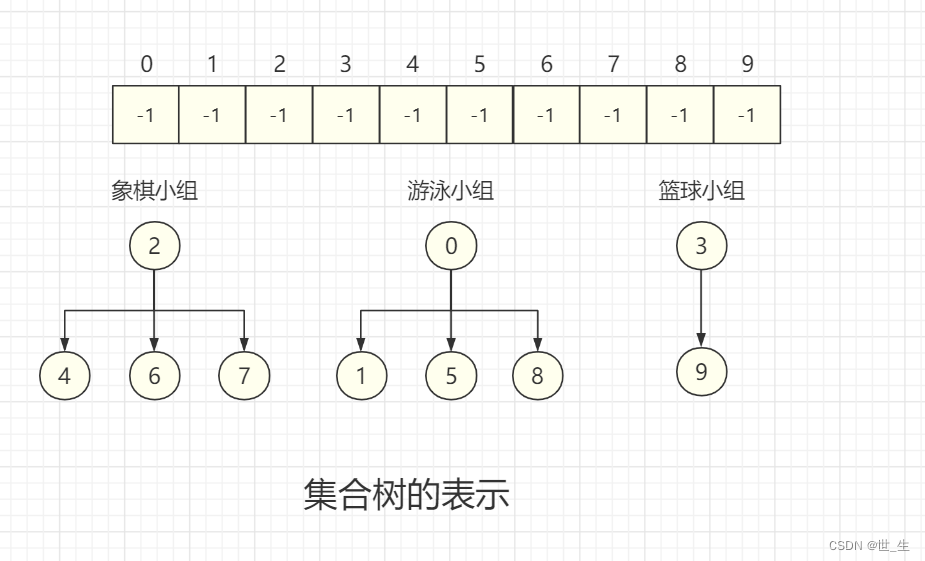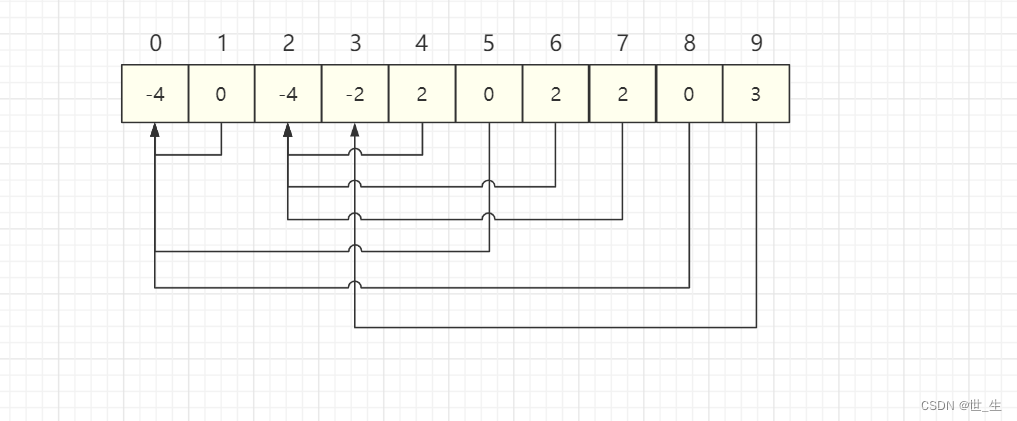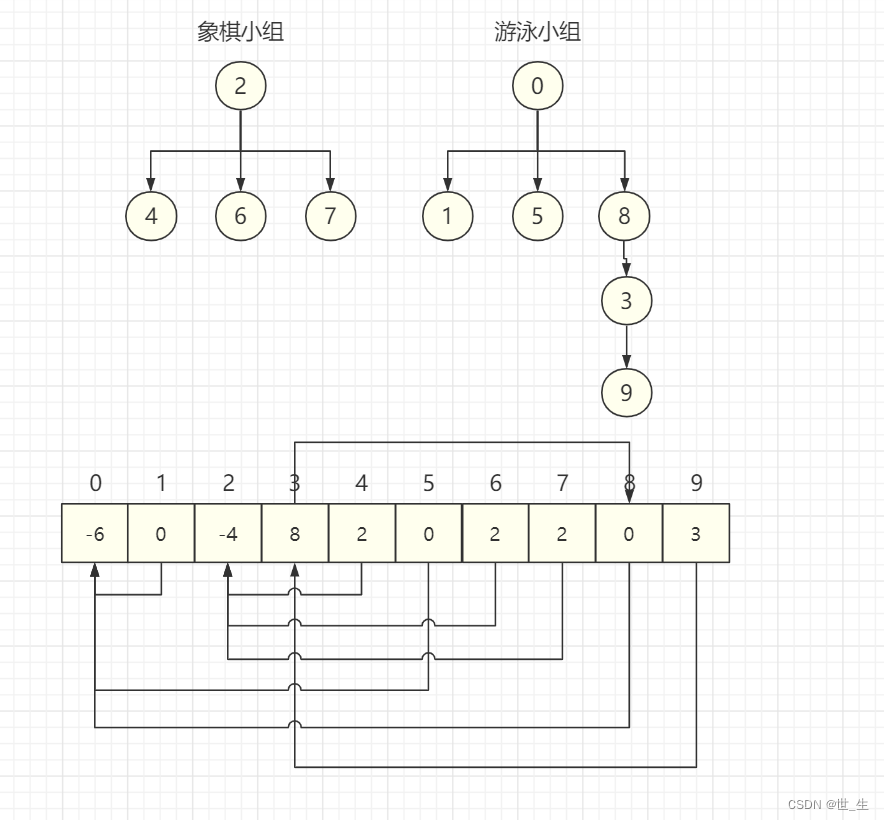并查集(C++)
发布时间:2024年01月05日
一、并查集的原理
并查集的两个功能:
- 合并:合并两个不想联系的元素
- 查询:判断两个元素是否在同一个组内
主要解决的是元素分组的问题。
例如:某班级要创建三个兴趣小组,分别是象棋、游泳、篮球。
班级总人数10人,现在需要不10人分别添加到三个兴趣小组中,每个人只能参加一个兴趣小组。
象棋小组:{2,4,6,7}
游泳小组:{0,1,5,8}
篮球小组:{3,9}
这里就可以使用到并查集。

在数组中的表示:
1.数组的下标对应集合中元素的编号(映射关系)
2.数组中如果为负数,负号代表根,数字代表该集合中元素个数
3.数组中如果为非负数,代表该元素双亲在数组中的下标

例如:由于篮球小组人比较少,某班级决定解散,成员合并到游泳小组。

- 数组0下标的数据变为-6
- 数组3下标的数据变为8
二、并查集的实现
代码实现:
1.使用vector容器
2.实现合并功能(一个节点只能附属一个根节点)
3.实现查询功能(判断两个节点的根节点是否相同)
#pragma once
#include<iostream>
#include<vector>
using namespace std;
template<class T>
class UnionFindSet {
public:
UnionFindSet(const size_t n)
:UFS(n,-1)
{}
//合并查集
void UnionSet(const int x,const int y)
{
int root1 = FindRoot(x);
int root2 = FindRoot(y);
if (root1 != root2)
{
//合并:控制数量少的往控制数量大的合并(合并意味着层数多了一层)
if (abs(UFS[root1]) < abs(UFS[root2]))
swap(root1, root2);
UFS[root1] += UFS[root2];
UFS[root2] = root1;
}
}
//寻找节点的根
int FindRoot(int index)
{
int temp = index;
while (UFS[index] >= 0)
{
index = UFS[index];
}
//子树全部去直接连接根(路径压缩)
while (UFS[temp] >= 0)
{
int next = UFS[temp];
UFS[temp] = index;
temp = next;
}
return index;
}
//计数森林的个数
int CountSet()
{
int count = 0;
for (auto n: UFS)
{
if (n < 0)
++count;
}
return count;
}
private:
vector<T> UFS;
};
路径压缩
1、数量少的森林往数量多的森林合并。(在合并的时候进行优化)
数量多的森林往往代表的查询频率多,如果往数量少的森林上合并,就会使原有的层数+1,提高了查询的成本。
2、子节点全部直接和根节点联系,降低森林的层数。(在查询的时候进行优化)
三、并查集的应用
题1思路:
- 矩阵的横、纵坐标代表这省份之间的联系,1代表联系需要合并,0代表不联系不需要合并。
- 最后计算森林的数量
题2思路:
- 建立字母和数组下标映射关系
- 合并==的两个字母
- 最后查询!=的两个字母是否有相同的根,有相同的根则false
结尾
不定期更新,给小编点点赞,为小编加加油,点赞?收藏不迷路噢~??

下一篇:讲解图。
文章来源:https://blog.csdn.net/qq_53505979/article/details/135415143
本文来自互联网用户投稿,该文观点仅代表作者本人,不代表本站立场。本站仅提供信息存储空间服务,不拥有所有权,不承担相关法律责任。 如若内容造成侵权/违法违规/事实不符,请联系我的编程经验分享网邮箱:chenni525@qq.com进行投诉反馈,一经查实,立即删除!
本文来自互联网用户投稿,该文观点仅代表作者本人,不代表本站立场。本站仅提供信息存储空间服务,不拥有所有权,不承担相关法律责任。 如若内容造成侵权/违法违规/事实不符,请联系我的编程经验分享网邮箱:chenni525@qq.com进行投诉反馈,一经查实,立即删除!
最新文章
- Python教程
- 深入理解 MySQL 中的 HAVING 关键字和聚合函数
- Qt之QChar编码(1)
- MyBatis入门基础篇
- 用Python脚本实现FFmpeg批量转换
- Linux文件系统中的目录
- 七人拼团模式:社交电商的新面目
- java的POI操作处理心得
- 【超详细】最简单的U盘重装Win10系统教程
- JVM工作原理与实战(一):初识JVM
- 如何让GPT成为你的论文助手?
- JavaScript进阶(事件+获取元素+操作元素)
- SCPMA最新研究论文推荐!中国移动&玻色量子发布联合研究成果
- 限流算法之固定窗口算法
- Web前端 ---- 【Vue】vue路由守卫(全局前置路由守卫、全局后置路由守卫、局部路由path守卫、局部路由component守卫)